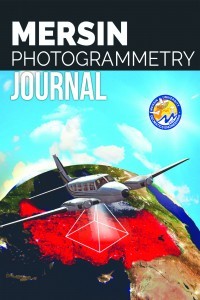THE EFFECT OF DIFFERENT FLIGHT HEIGHTS ON GENERATED DIGITAL PRODUCTS: DSM AND ORTHOPHOTO
THE EFFECT OF DIFFERENT FLIGHT HEIGHTS ON GENERATED DIGITAL PRODUCTS: DSM AND ORTHOPHOTO
___
- ATLIS Geomatics,http://www.atlisgeo.com/expertise/process/dem-dtm/ [Accessed 17 Oct. 2019].
- Bogaziçi Construction Consultancy A.Ş. (BIMTAS),https://bimtas.istanbul/lttmDem.aspx [Accessed 15 Oct. 2019a].
- Bogaziçi Construction Consultancy A.Ş. (BIMTAS), https://bimtas.istanbul/bimtas-galeri-lttm.aspx?kls=DSM [Accessed 15 Oct. 2019b].
- Ceylan, M., Doner, F. and Ozdemir, S. (2014). “Use of unmanned aerial vehicle systems in data collection and mapping studies.” 5. Remote Sensing-GIS semposium, Istanbul, Turkey.
- Dellaert, F. Seitz, S. M., Thorpe, C. E. and Thrun, S. (2000). “Structure from motion without correspondence. Proceedings.” IEEE Conference on Computer Vision and Pattern Recognition, CVPR 2000 (Cat. No.PR00662), Hilton Head Island, SC, pp. 557-564 Vol. 2, doi: 10.1109/CVPR.2000.854916.
- Eisenbeiss, H. (2003). Positions und orientierungsbestimmung eines autonomen helikopters-vergleich zwischen direkter georeferenzierung und aerotriangulation mit videobilddaten, Diploma Thesis, Institute for Photogrammetry and remote sensing, University of Technology, Dresden, Germany.
- Eisenbeiss, H. (2004) “A mini unmanned aerial vehicle (UAV): system overview and image acquisition.” International Archives of Photogrammetry, Remote Sensing and Spatial Information Sciences, vol. 36, part 5/W1, on CD-ROM.
- Eisenbeiss, H. (2009). UAV Photogrammetry, ETH Zurich for the degree of Doctor of Science, ISNN 0252-9335, ISBN: 978-3-906467-86-3, Zurich, Switzerland.
- Furukawa, Y., Hernández, C. (2013). “Multi-View Stereo: A Tutorial.” Foundations and Trends® in Computer Graphics and Vision, Vol. 9, No. 1-2, pp. 1-148.
- Kraus, K. (2007). “Photogrammetry, Geometry from Images and Laser Scans (2nd edition)”,Walter de Gruyter, Berlin, Germany.
- Kolzenburg, S., Favalli, M., Fornaciai, A., Isola, I., Harris, A. J. L., Nannipieri, L. And Giordano, D. (2016). “Rapid updating and improvement of airborne lidar DEMs through ground-based sfm 3-d modelling of volcanic features.” IEEE Transactions on Geoscience and Remote Sensing, Vol. 54, No. 11, pp. 6687-6699.
- Marangoz, A., M. (2014). “Lecture notes on photogrammetry II”, Bülent Ecevit University, Zonguldak, Turkey.
- Newhall, B. (1969). “Airborne camera: The world from the air and outer space.” Hasting House Trowbridge&London, pp. 144.
- Nex, F. and Remondino, F. (2014). “UAV for 3D mapping applications: a review.” Applied Geomatics, Vol. 6, Issue 1, pp.1-15.
- NIK Construction Tic. Ltd. Sti. http://www.nik.com.tr/content_sistem_alt.asp?id=84 [Accessed 14 Oct. 2019].
- Ozemir, I. and Uzar, M. (2016). “The generation of photogrammetric data with unmanned aerial vehicle.” 6. Remote Sensing-GIS DEMposium, Adana, Turkey, pp. 245-254.
- Parrot (2018) “Anafi User Manual v2.2.” pp.1-73.
- Rawat K. S. and Lawrence E. E. (2014). “A mini-UAV VTOL Platform for Surveying Applications.” International Journal of Robotics and Automation (IJRA) Vol. 3, No. 4, pp. 259-267.
- Sariturk, B. and Seker D.Z. (2017) “Comparison Of Commercial And Open-Source Software Used In 3d Object Modeling With Sfm Technique.” Afyon Kocatepe University Journal of Science and Engineering, Special Issue, pp. 126-131.
- Seren, A. M. and Demirel, H. (2016). “3 Dımensıonal Modellıng Of Large Objects In Open-Space: A Comparıson Of Recent Methodologıes In Geomatıcs Engıneerıng”. 8. National Engineering Surveys Symposium, Yıldız Technical University, Istanbul, Turkey.
- Sweeney, C. (2016). Theia Visison Libraryhttp://www.theia-sfm.org/sfm.html [Accessed 11 Oct. 2019].
- Whittlesley, J. H. (1970). “Tethered Balloon for Archaeloogical Photos, In Photogrammetric Engineering.” 36 2, pp. 181-186.
- Yakar, M. and Dogan, Y. (2017). “3D Modelling of Silifke Asagi Dunya Sinkhole by Using UAV.” Afyon Kocatepe University Journal of Science and Engineering, Special Issue, pp. 94-101.
- Yasayan, A. (2011). “Photogrammetry.” T.C.Anadolu Üniversitesi Yayını, No: 2295. Acıkoğretim Fakültesi Yayını, No:1292, Eskisehir, Turkey
- Morgan, J. A. and Brogan, D. J. (2016). “How to Visual SFM”. Department of Civil & Environmental Engineering Colorado State University Fort Collins, Colorado.
- Yayın Aralığı: Yılda 2 Sayı
- Başlangıç: 2019
- Yayıncı: Mersin Üniversitesi
LIGHT RAIL LINE DESIGN FOR EAST BLACK SEA REGION: A CASE STUDY OF TRABZON
Hatice ÇATAL REİS, Abdulkadir BİRİNCİ
AUTOMATIC ROAD DETECTION FROM ORTHOPHOTO IMAGES
Abdurahman Yasin YİĞİT, Murat UYSAL
3D MODELLING OF KAYSERI TEKGOZ BRIDGE
Ali ULVİ, Abdurahman Yasin YİĞİT
THE EFFECT OF DIFFERENT FLIGHT HEIGHTS ON GENERATED DIGITAL PRODUCTS: DSM AND ORTHOPHOTO
Mehmet Özgür ÇELİK, Aydın ALPTEKİN, Fatma BÜNYAN ÜNEL, Lütfiye KUŞAK, Engin KANUN
INVESTIGATION OF PHENOLOGICAL STAGES OF WHEAT PLANT USING VEGETATION INDEX
